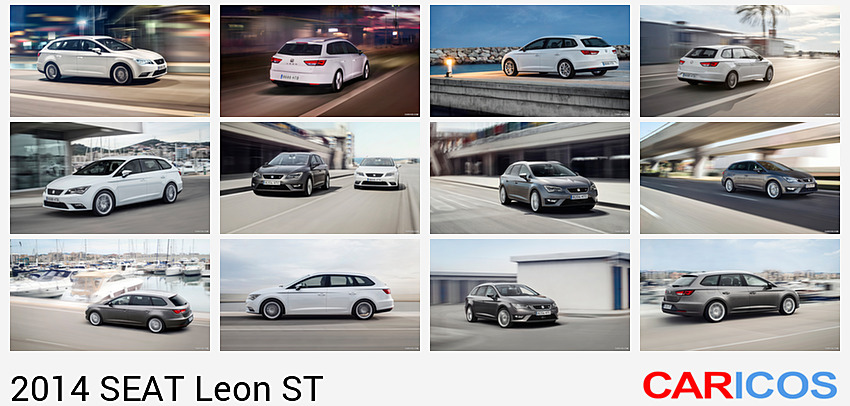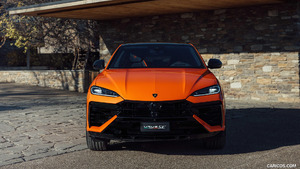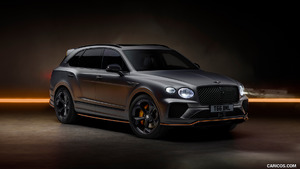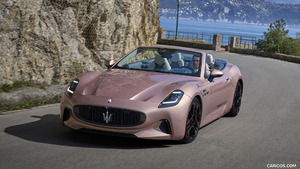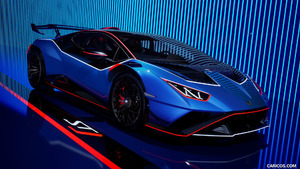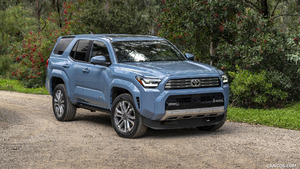SEAT Leon ST
The new SEAT Leon ST demonstrates that thrilling sporting character and exceptional everyday usability do not have to be mutually exclusive. The third member of the Leon family combines the young, dynamic design and the precise handling of its siblings with an amazing degree of utility. Like every Leon, the ST displays an impressive level of craftsmanship and premium materials. The luggage space of the 4,535 mm compact estate car offers excellent variability and the very best functionality down to the last detail. It has a load capacity of 587 litres, rising to as much as 1,470 litres with the rear seat backrests folded - meaning that even the big items of everyday life are best accommodated in the Leon ST.
“Nobody has to choose anymore between sporty and practical. The new Leon ST offers both,” says Jürgen Stackmann, President and CEO of SEAT S.A. “With its sporty look, its surprisingly high utility and its state-of-the-art technology, the Leon ST defines a new standard in the compact estate car class – at a very fair price. Like the already highly successful Leon and Leon SC, the new ST is the perfect representative of SEAT’s brand values.”
The design of the Leon ST continues the emotional SEAT design language, as well as its high level of quality in materials and workmanship. The line-up of state-of-the-art engines is extremely broad, with the power spectrum of TDI and TSI drives ranging from 63 kW (86 PS) to 135 kW (184 PS). The exceptionally efficient new 1.6 TDI Ecomotive with 81 kW (110 PS) achieves fuel consumption of just 3.2 litres per 100 km in the NEDC (New European Driving Cycle), equating to a CO2 figure of only 85 grams per km.
The new estate from SEAT handles with just as much precision and agility as the Leon and Leon SC. Alongside the Reference and Style equipment lines, the FR - the most dynamic model variant - underscores the leading position it holds among sporty compact estate cars.
“The new Leon ST perfectly combines the SEAT DNA with functionality and versatility. The Leon ST offers the same dynamic driving fun for which the Leon has already established an excellent reputation,” says Dr. Matthias Rabe, Vice President of Research and Development for SEAT S.A.
The extensive range of hi-tech options such as the full-LED headlamps is expanded by the ACC Automatic Proximity Control and DCC Adaptive Chassis Control. The optional progressive steering enables a high degree of control under sporty driving conditions.
The new SEAT Leon ST is manufactured at the Martorell factory near Barcelona in Spain. Since the premiere of the first Leon generation in 1999, SEAT has sold more than 1.2 million vehicles from this successful model range.
THE DESIGN – FURTHER ACCENTUATED
The much applauded design language of the Leon range has been further accentuated for the ST. Here, too, sculpted lines along the sides deliver a thrilling interplay of light and shade. The estate also features the same sharp lines and precise edges that communicate energy and vitality. The new estate adds a whole new dimension to the Leon family – the dynamic silhouette looks taut and elegant, yet the Leon ST offers comprehensive utility for work and leisure, family and sport.
“In the development of the new Leon ST, we have fully retained the dynamic essence of SEAT design,” says Alejandro Mesonero-Romanos, Head of SEAT Design. “The roofline follows almost exactly the same line as the five-door, just stretched a little farther back. While the wheelbase remains the same, an extra 27 centimetres on the bodyshell allows the car to offer the luggage volume of a fully fledged estate car.”
The side view of the new SEAT Leon ST displays harmonious yet exciting proportions. This includes a balanced relationship between metal and glass surfaces – the vertical proportion of glass to bodyshell is one to three. This clear division accentuates the solidity and underscores the refined stance of the elegant estate car. The slight taper of the side window surfaces towards the rear emphasises the feeling of spaciousness, which can be further enhanced by the optional panoramic glass roof. The standard roof rail accentuates the gentle tension of the roofline.
The extra 27 centimetres added to the rear end provide some indication of the generous estate luggage space available within, while the low rear windscreen and muscular shoulders emphasise the car’s dynamic character. With its even more expressive design front and rear, the FR variant of the Leon ST brings whole new meaning to the term sports estate.
Space and versatility
Despite its uniquely dynamic design, the new Leon ST is surprisingly spacious and exceptionally versatile. The load capacity stands at 587 litres in the standard configuration, rising to as much as 1,470 litres with the rear seat backrests folded. Furthermore, certain equipment variants can also accommodate extra-long loads by folding forward the passenger seat backrest, giving a maximum load length of 2.67 metres.
The ST also offers a host of further functional equipment details that considerably enhance its everyday usability. The rear seat backrests, for instance, are very easy to fold forward from the boot; an optional Boot Pack comes with more features such as bag hooks for bringing order to the boot space. This includes the double load floor, which makes loading and unloading particularly easy. The Family Pack incorporates retractable sun shades for the rear doors and folding tables on the rear of the front-seat backrests.
THE INTERIOR – PREMIUM AND FUNCTIONAL
The accentuated dynamics of the exterior continue seamlessly in the interior of the new SEAT Leon ST. The space for the driver and front seat passenger has a clear and well balanced layout. All switches, buttons and levers are where they would intuitively be expected to be. The broad centre console is a notable feature, with its clear orientation towards the driver. The instrument panel is extremely elegant and, due to its two-tone design, seems to float slightly in mid-air.
Alejandro Mesonero-Romanos, Head of SEAT Design says of the interior: “We used ergonomics as the benchmark in designing the light and elegant interior, orientating our thinking around the precision of an aircraft cockpit. The driver of the Leon ST has no unnecessary distraction and can concentrate fully on driving.”
Fine details highlight the very high level of workmanship in the new Leon ST – details such as the large air vents, the easy-to-understand air conditioning controls and the three-dimensional trim elements. All surfaces have a soft-touch finish for a satisfying tactile experience every time. In some versions, the premium feel is further enhanced through fine chrome and leather applications.
The large instrument dials are easy to read, with the driver information system standard as of the Reference line. The display is located directly in the driver’s line of sight and provides information on average fuel consumption, range and speed. Depending on the version, it also provides data from the navigation system, the driver assistance systems or from a mobile phone connected via Bluetooth.
In designing the new SEAT Leon ST, a great deal of emphasis was laid on functionality and flexibility. There are no fewer than a dozen stowage trays and cubbies plus five closed storage bins located in the doors, the centre console and in front of and between the front seats. The front stowage bin in the centre console is extremely spacious. Keys, mobile phones or other everyday items can be stored here quickly and safely.
The newly designed driver and front passenger seats in the Leon ST are low-slung and sporty and extremely comfortable for people of all sizes. The seats guarantee the very best grip under dynamic driving conditions and are exceptionally comfortable over long distances. This was achieved through ergonomic design of the foam contours, as well as further improvements to the spring and damping characteristics of the cold-cure foam cushion elements. A large selection of premium fabrics, leather and Alcantara upholstery ensures that all individual desires are fulfilled.
Weight was saved during the development of the standard-fit driver and passenger side airbags, which are now installed without plastic housings. Instead, the folded airbags are now integrated into the seat backs. The weight saving of around 25 percent is paired with a significant improvement in protection.
THE BODYSHELL – SYSTEMATIC LIGHTWEIGHT DESIGN
The extremely good fuel consumption figures are also a consequence of systematic lightweight design. In the base version, the Leon ST has a kerb weight of just 1,233 kilograms, making it the lightest estate car in its class. If it is to offer optimum safety and the best possible comfort, a bodyshell has to be solid. An intelligent structure guarantees that the vehicle remains light and efficient. Solid and light – SEAT set itself this challenge, and equipped the new Leon ST with a state-of-the-art body-in-white.
“Systematic lightweight design is a clear strength of the new Leon ST, too. The low vehicle weight aids dynamics and efficiency in equal measure,” says Dr. Matthias Rabe, Vice President of Research and Development for SEAT S.A. “The extremely stiff bodyshell also forms the basis for an excellent overall feeling of quality.”
In order to maintain optimum value-for-money, the decision was taken to forego cost-intensive materials like magnesium and carbon fibre – instead, many places feature high-strength and ultra-high-strength steels. These hot-formed hi-tech steels alone reduce the weight by 18 kilograms, while providing even greater stiffness to the occupant cell.
The body-in-white of the five-door variant of the Leon is lighter than the preceding model by no less than 25 kilograms. And for the new Leon ST, too, systematic lightweight design was implemented across all elements of the vehicle. Thus, a great many parts in the engines, chassis and interior also make a contribution to weight reduction. Overall, the Leon ST weighs just 45 kilograms more than the comparable five-door model.
One example of the many lightweight design initiatives is the all-new air conditioning. With its highly efficient cooling system and quiet operation, it sets the benchmark in efficiency and comfort. Ideal air distribution was as much the focus of development work as was fast and even windscreen de-icing in frosty temperatures. The significant weight saving of 2.7 kilograms was achieved through optimisation of the design and packaging.
Panoramic sunroof
The optional panoramic sunroof delivers a very bright and airy sense of space, especially for back-seat passengers – and, with its large, black surface, provides an additional design element, particularly in combination with light-coloured paintwork. The front section of the glass roof can be retracted over the fixed rear section – and can also be opened and closed using the remote-control key.
THE DRIVE – EFFICIENT DYNAMICS
The Leon ST comes with an extensive engine line-up. SEAT is sending the new sports estate into battle with powerful and fuel-efficient TDI and TSI power units ranging from 1.2 to 2.0 litres displacement. All engines feature direct injection with turbocharging and have been optimised for low internal friction and rapid warm-up.
“Our engines use state-of-the-art efficiency technologies and have outstanding fuel consumption figures,” says Dr. Matthias Rabe, Vice President of Research and Development for SEAT S.A. “We are vigorously pursuing our strategy of offering performance and driving fun combined with optimum resource conservation.”
The choice of petrol engines is extremely broad. The 1.2 TSI comes in two versions with 63 kW (86 PS) and 77 kW (105 PS). In both power variants, NEDC fuel consumption stands at 5.2 litres per 100 km, equating to 119 grams of CO2 per km. With Start/Stop and Energy Recovery, the 77 kW engine consumes just 4.9 litres per 100 km (CO2: 114g/ km).
The 1.4 TSI with 90 kW (122 PS) is a state-of-the-art unit delivering 200 Nm of torque. The engine comes with start/stop and energy regeneration as standard and consumes just 5.3 litres of super-grade petrol per 100 kilometres in the NEDC, (CO2: 123 g/km). The TSI range is further enhanced by a 1.4 TSI with 103 kW (140 PS) and an average fuel consumption of 5.3 litres per 100 kilometres (CO2: 121 g/km).
The pinnacle of the petrol line-up is the FR with the 1.8 TSI delivering 132 kW (180 PS) and 250 Newton metres of torque. Paired with the fast-shifting DSG, it has fuel consumption of just 5.7 litres per 100 km (CO2: 132 g/km).
The turbodiesel line-up offered in the new SEAT Leon ST covers a broad performance spectrum ranging from 66 kW (90 PS) to 135 kW (184 PS). The entry-level engine is the 1.6 TDI with 66 kW (90 PS) and a respectable 230 Nm of torque. It consumes 4.1 litres per 100 km and emits 108 grams of CO2 per km. In the version with 77 kW (105 PS), the 1.6 TDI produces 250 Nm of torque. With start/stop and energy regeneration, it consumes just 3.8 litres of diesel per 100 kilometres in the NEDC (CO2: 99 g/km).
The 2.0 TDI with 110 kW (150 PS) and 320 Nm of torque provides the new SEAT Leon ST with ample propulsion; yet, with start/stop and energy regeneration, it makes do with an average of just 4.1 litres of fuel per 100 km (CO2: 106 g/km). A sporty highlight is set by the 2.0 TDI with 135 kW (184 PS) and 380 Nm of torque, which is available exclusively in the FR and sips just 4.3 litres of fuel per 100 km (CO2: 112 g/km).
When it comes to transferring power to the wheels, the transmissions on offer vary in accordance with the engine from a five or six-speed manual to the compact and lightweight DSG dual-clutch gearbox. It changes its six or seven gears in a matter of milliseconds and is incredibly efficient. Certain variants come with a freewheeling function, which reduces real-life fuel consumption even further.
The new 1.6 TDI Ecomotive
| 1.6 TDI Ecomotive | |
| kW/PS | 81/110 |
| Nm/rpm | 250 1,500-3,000 |
| Vmax/ km/h | 197 |
| 0-100/s | 10.7 |
| l/100 km | 3.2 |
| CO2 | 85 |
The Ecomotive variant of the new SEAT Leon ST is one of the most fuel-efficient cars of our time. With its average fuel consumption of just 3.2 litres per 100 kilometres and a similarly low CO2 figure of just 85 grams/km, the Leon ST Ecomotive is incredibly cost-effective to drive and has extremely low emissions. But, thanks to its brand new 1.6 TDI engine with 81 kW / 110 PS and a torque of 250 Newton metres, the Leon ST Ecomotive also offers a very dynamic drive, with its top speed standing at 197 km/h. Plus its theoretical range of an impressive 1,500 kilometres reduces refuelling stops to an absolute minimum.
The 1.6-litre belongs to the latest generation of TDI engines, with features such as under-bonnet exhaust-gas treatment, innovative thermal management with separate cooling of engine block and cylinder head, and charge-air cooling integrated into the intake manifold. The internal friction of the entire engine has been further optimized – a key factor in the continued improvement of efficiency.
The start/stop system, energy regeneration, the specially adapted six-speed manual transmission and the extremely low rolling resistance tyres are major contributors to the low consumption figures. They are further enhanced by the optimised aerodynamics of the slightly lowered bodyshell with partially closed air intakes at the front, additional underbody cladding and a roof spoiler.
THE CHASSIS – DYNAMIC AND COMFORTABLE
The well balanced chassis reinforces the dynamic character of the new SEAT Leon ST. The suspension smoothes out all manner of uneven surfaces, while the steering has refined, calm directionality and an excellent level of feedback.
The sporty estate car uses an all-new vehicle architecture that has been developed from scratch. Its engines are all angled at 12 degrees to the rear. This and the compact engine layout enabled engineers to move the front axle forward by 40 millimetres. The results are a comparatively long wheelbase and a well balanced distribution of axle load - factors that have a major impact on comfort and sporty handling.
At the front are MacPherson struts on a subframe. The Leon Sports Tourer responds quickly and precisely to steering input, mastering all manner of bends and corners with relaxed stability. The ratio of the new speed-sensitive electromechanical power steering is sporty and direct. It makes a significant contribution to the efficiency of the new SEAT Leon ST because it consumes no energy during straight-line driving. The turning circle measures just 10.2 metres.
On engine versions up to 110 kW (150 PS), the rear end is equipped with a torsion bar suspension. The more powerful variants use a multi-link set-up that handles longitudinal and transverse forces independently of one another. Shock absorbers and coil springs are mounted separately to deliver a particularly refined response. An electronic transverse differential lock applies tiny braking impulses to the lighter inside front wheel to make handling at the cornering limits safer and even more fluid. The ESC electronic stability program has been perfectly adapted, while the braking system on the new SEAT Leon ST is also a match for even the toughest conditions.
SEAT Drive Profile with DCC Adaptive Chassis Control and Progressive Steering
The character of the FR version of the new SEAT Leon ST with 132 kW (180 PS) or 135 kW (184 PS) can be individualised to suit both mood and situation: The SEAT Drive Profile enables the driver to vary the characteristics of the power steering, throttle control and DSG transmission in three modes – eco, comfort and sport, plus an additional individual setting.
For the FR, SEAT also offers the latest generation of the DCC Adaptive Chassis Control with three different modes that can be selected via the SEAT Drive Profile. In the “Sport” mode, the Leon ST is even more agile, while the set-up in “Comfort” mode is considerably more relaxed. The DCC system adaptively regulates the damper valves and thus the damping characteristics. The DCC also uses input signals from the wheel travel and acceleration sensors, as well as vehicle information from the chassis CAN bus. This ensures that the correct damping force is calculated and adaptively applied in accordance with every driving situation. For the first time, the new-generation DCC can now vary the rebound and compression damping fully independently of one another during dynamic lateral manoeuvres, too – a major benefit in optimizing handling characteristics.
Alongside DCC, the optional Dynamic Pack for the Leon ST FR includes progressive steering. It reduces the steering effort during low-speed manoeuvres, while increasing handling dynamics with more direct steering characteristics on winding roads. Thanks to this steering, the driver is able to use smaller steering movements to achieve the desired cornering radii; this means that, on tight bends and hairpins, he has to adjust his grip less frequently. Steering lock is 1.1 turns with the progressive steering; with the standard steering, it is 1.4. This is because conventional steering systems apply a constant steering ratio. The new progressive steering operates with a progressive ratio. This noticeably reduces steering effort when parking or manoeuvring. Due to the more direct set-up, the driver will notice improved dynamics on winding country roads and when turning corners.
The main technical differences between the progressive and the standard steering are variable gearing on the steering rack and a more powerful electric motor.
The SEAT Drive Profile in the Leon ST FR with the 1.8 TSI (180 PS) and 2.0 TDI (184 PS) also influences the engine sound, which is modulated via a sound actuator, as well as the interior ambient lighting – depending on driving style, the LEDs in the doors switch between white (comfort, eco and individual) and red (sport).
THE DRIVER ASSISTANCE SYSTEMS – RELIABLE AND ALERT
SEAT engineers have compiled an impressive package of the very latest driver assistance systems for the new Leon ST. They include ACC with Front Assist, drowsiness detection and the two camera-based systems, Full Beam Assist and lane-keeping assistant Heading Control.
A further important safety system that comes as standard in the new SEAT Leon ST is the multi-collision brake, which helps avoid secondary collisions in the event of an accident.
ACC with Front Assist
A new feature among the driver assistance systems for the SEAT Leon is the ACC adaptive cruise control. The radar-based system maintains the pre-set speed and pre-selected distance to the vehicle in front, accelerating and decelerating automatically in flowing traffic. The speed can be set within a range of 30 to 160 km/h. ACC works with manual transmissions and with DSG. On vehicles with DSG, the system will decelerate behind a slowing vehicle all the way to a standstill.
Front Assist including the city emergency braking function can guard against the danger of collisions by using a radar sensor to monitor traffic in front of the vehicle. If a critical risk of a rear-end collision is detected at speeds ranging from 30 to 210 km/h, the assistant warns the driver both acoustically and optically and prepares the brake system for a possible braking manoeuvre. The Leon thus puts the driver in the position to address the precarious situation him/herself.
If required, the system will automatically initiate the braking manoeuvre, potentially reducing the speed of impact. Front Assist also aids the driver during the braking manoeuvre itself, ensuring – if necessary – that maximum braking force is applied. Thus “Front Assist” can make a major contribution to protecting occupants and vehicle.
The city emergency braking function is a system extension of Front Assist that operates in urban stop-and-go traffic. At speeds of between 5 and 30 km/h, it can react in the final moments prior to a collision with an emergency braking manoeuvre.
Drowsiness detection
The system, which is optional as of the Reference line, analyses the driver’s characteristic steering input and continuously evaluates permanent signals like steering angle or steering speed. The drowsiness detection system registers when the driver’s concentration is failing and emits an acoustic warning signal supplemented by a display symbol that recommends taking a break.
Should the driver elect not to take a break within the subsequent 15 minutes, the warning is repeated. Independently of this, the activated system advises the driver to take a break after four hours of uninterrupted driving.
Full Beam Assist
A camera system integrated into the base of the rear-view mirror controls Full Beam Assist (upwards of 60 km/h), switching automatically between full and dipped beam. It identifies oncoming traffic and vehicles driving in front, as well as illuminated residential areas, thus ensuring that other road users are not dazzled.
Lane-keeping assistant
The camera-based lane-keeping assistant Heading Control makes slight adjustments to the electromechanical steering before the driver deviates from course and crosses a lane marking.
TECHNOLOGIES – INNOVATIVE SOLUTIONS
Packed into the new SEAT Leon ST are a whole host of innovations. It combines dynamic design with state-of-the-art technologies. The optional full-LED headlights are a true first in the compact class, while the up-to-the-minute operating system SEAT Easy Connect works with a touchscreen measuring up to 5.8 inches.
“With the new Leon ST, we have developed a compact sports estate that fulfils both the emotional and the rational demands of our customers in equal measure,” says Dr. Matthias Rabe, Vice-President of Research and Development for SEAT S.A.
Full-LED headlights
Innovative full-LED headlights in combination with LED rear lights are available as options for the new SEAT Leon ST. Alongside their expressive design, LED headlights have many further benefits – for instance, they illuminate the road with a colour temperature of 5,300 Kelvin. Because this is very similar to that of daylight, it puts very little strain on the eyes. In terms of efficiency, the LEDs consume very little energy; dipped beam, for instance, draws only 20 watts per unit.
The distinctive contour of the positioning and daytime running lights on the new SEAT Leon ST is generated by two white LEDs per unit. Nine yellow LEDs on each side provide the light for the indicators, which are likewise integrated into the headlamp unit. The dipped beam is made up of six modules each. When the main beam is switched on, three bright spot modules are activated in each unit and the dipped beam is raised accordingly.
Intelligent sensors prevent oncoming traffic from being dazzled. Furthermore, the new full-LED headlights are completely maintenance free and designed to last the lifetime of the car.
The functions of the full-LED headlights include a motorway light. The angle of the beam is raised slightly as soon as the Leon ST travels at speeds above 110 km/h for more than 30 seconds. This improves illumination of the carriageway without irritating other road users.
SEAT EASY CONNECT – THE LATEST GENERATION IN INFOTAINMENT
The new SEAT Leon ST is coming to market with a wide selection of state-of-the-art infotainment solutions. The foundation for this is the SEAT Easy Connect operating system, which enables the control of entertainment and communication functions, in addition to numerous vehicle functions, via a cockpit touchscreen. Measuring up to 5.8 inches, the touchscreen and its associated buttons and rotary controls are located centrally in a convenient position between the central air vents. It is easy to read and to reach for both driver and front seat passenger.
For the first time, SEAT is using a touch-sensitive screen with proximity sensor (5.8-inch screen). As soon as the driver’s or passenger’s finger approaches the touchscreen, the system automatically switches from display to operating mode. In operating mode, the elements that can be activated via the touchscreen are brought to the fore, making intuitive use (smartphone-style swipe and zoom gestures) even easier. The display mode, on the other hand, is distinguished by its extremely clear and uncluttered presentation. The graphics of both modes are a perfect match for the sporty aesthetic of the SEAT design.
Media System Touch (5-inch)
The entry level is the Media System Touch with a 5-inch touchscreen monitor, radio with SD-card slot and four speakers. External devices for playing individual playlists can be connected via USB or aux-in points. Three buttons arranged on either side of the touchscreen activate the functions “Radio”, “Media”, “Car”, “Setup”, “Sound” and “Mute”. Media System Touch is standard equipment with the Reference equipment line.
Media System Touch Colour (5-inch)
In the Style and FR, Media System Touch Colour with SD-card slot, CD drive (MP3 capable) and six speakers is part of the standard equipment. It connects to external devices via Bluetooth, USB or aux-in. Its colour, 5-inch touchscreen also serves to control vehicle functions.
Media System Plus (5.8-inch)
The Media System Plus comes with a 5.8-inch touchscreen with three-dimensional graphics, as well as an optional DAB tuner for digital radio reception and voice control. The system delivers sound to eight speakers. There are four buttons on each side of the touchscreen; in addition to those provided with the 5-inch systems and depending on equipment, they provide access to the functions “Phone” and “Voice”. The connector unit for SD cards, USB and iPod is located in the glove compartment. The high-resolution screen offers a wide array of colours.
Navi System (5.8-inch)
The top solution is the same as Media System Plus, but incorporates the voice-controlled navigation system. Route guidance information is also displayed on the colour screen between the speedometer and rev counter, directly in the driver’s line of sight.
SEAT sound system
The optional SEAT sound system with 135-watt output and ten speakers offers clear and powerful sound at all five seats. A large proportion of this impressive listening experience is attributable to the centre speaker integrated into the dashboard and the large 35-watt subwoofer in the luggage compartment.
THE EQUIPMENT – INDIVIDUAL STYLE
The new SEAT Leon ST is already on sale in many European markets - with highly competitive pricing and extensive equipment. The four equipment lines on offer are Leon, Reference, Style and FR.
In addition to the standard equipment, there are also a wide range of safety, comfort and sport options available for the new SEAT Leon ST. They include full-LED headlamps, front arm rests, the electric panoramic roof, automatically dimming rear view mirror, the foldable passenger-seat backrest, light and rain sensors, the SEAT sound system and the navigation system.
Leon
Seven airbags and the electronic stability control (ESC) incl. anti-lock brakes (ABS) and anti-slip regulation (ASR) are part of the standard equipment package on all versions of the SEAT Leon ST. In addition to that are electric windows up front, electrically adjustable wing mirrors, daytime running lights, an outside temperature display, remote central locking, a height-adjustable driver’s seat and Isofix and Top-Tether anchor points in the rear for child seats. The grille is framed in chrome, while the door handles and wing mirrors are painted in body colour. The entry-level Leon ST stands on 15-inch wheels. The black roof rail on the Leon ST and Reference versions underscores the dynamic body line.
Reference
The Leon ST Reference comes with several added comfort features. The extensive standard equipment is complemented by electrically adjustable and wing mirrors, an air conditioning system with manual controls, the Media System Touch and the rear-seat backrest with a 60:40 split.
Style
The Leon ST Style offers compelling value for money. It comes with 16-inch alloy wheels, fog lamps with cornering light function, electric windows in the rear, cruise control, Media System Touch Colour with six speakers and mobile phone connection via Bluetooth. The multi-function steering wheel rim is clad in leather and the wing mirrors are heated. The centre console incorporates an arm rest with storage bin, as well as a separate air vent for rear-seat passengers. The interior is available three colour combinations: black, black and grey or beige. The optional leather trim also comes in a choice of black, black and grey or beige. Alcantara trim is also available. In both the Style and FR variants, the rear-seat backrest can be folded forward from the luggage compartment. The loading edge is finished in chrome, while the roof rail on Style and FR is silver.
FR
Sporty SEAT variants traditionally bear the FR badge. The Leon ST FR is recognisable by its 17-inch alloy wheels, sporty bumpers, dedicated FR suspension, tinted rear windows, folding wing mirrors and LED rear lights. Inside, it offers aluminium entry sills, a leather-clad sports steering wheel, sports seats with lumbar support, ambient lighting and Climatronic. Using the SEAT Drive Profile, the driver can adapt the vehicle settings to suit the driving conditions. The fine sound of Media System Touch Colour is delivered through eight speakers. The trim options are black leather or Alcantara.

